If there's one thing Iceland is not short of, then it's volcanoes.
The country is also known as the land of ice and fire thanks to its breathtaking glaciers and plentiful volcanic activity. Ever wondered why there are so many volcanoes in Iceland or how many are still active? You've come to the right place because we're about to answer every question you may have had on this ultimate guide to volcanoes in Iceland.
What actually is a Volcano?
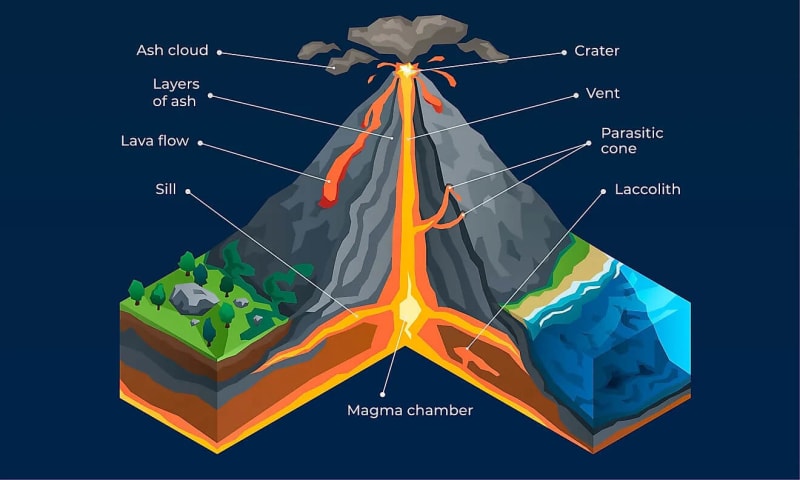
There are three classifications of volcanoes: extinct, dormant, active.
- Extinct, or dead volcano, means the volcano hasn't erupted in the last 10,000 years and is not expected to erupt again in the future.
- Dormant means the volcano is sleeping, and therefore it hasn't erupted in around 10,000 years but it could awaken in the near future.
- Finally, an active volcano is one that has recently erupted or has done so in the last 10,000 years. Iceland has plenty of dormant, extinct, and active volcanoes!
More info about this here: What is a volcano?
How Many Volcanoes does Iceland have?
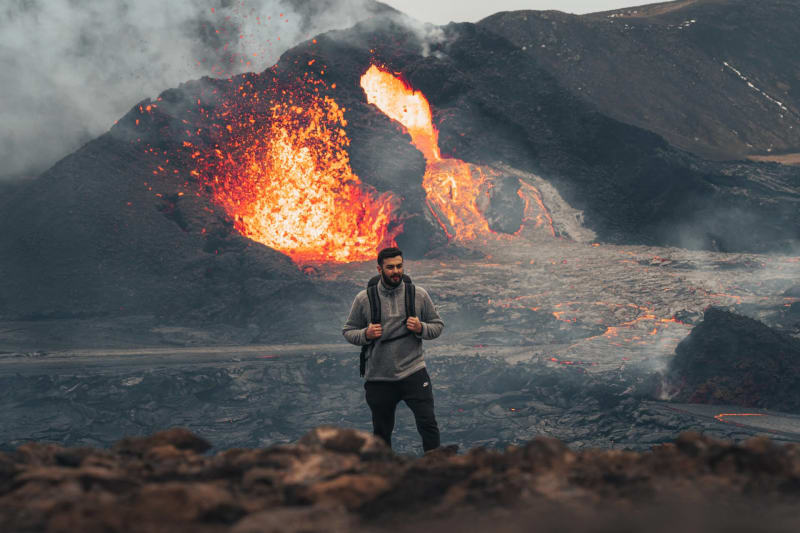
Why are there so many Volcanoes in Iceland?
Iceland is located directly on the Mid Atlantic Ridge, which separates the Eurasian tectonic plate and the Northern American plate. These two plates are divergent, which means that they are pulling away from each other. Therefore, technically speaking, Iceland is growing at a rate of around 2 centimeters every year. Because the two tectonic plates are pulling away from each other this creates many openings for magma from the Earth to rise up to form volcanic eruptions.
Iceland is one of the few places where you can see the Mid Atlantic Ridge above sea level. Þingvellir National Park is perhaps the best place to experience the two plates. Not only can you stand between the Eurasian and North American plate, but you can also snorkel through it if you so wish.
How Often are there Volcanic Eruptions in Iceland?
Volcanic eruptions occur on a regular basis in Iceland and are often very unpredictable. There has been an eruption every decade since the late 18th Century. Of course, some volcanic eruptions have been more intense than others.
The most recent known eruption in Iceland was in 2021 when a minor eruption took place in Fagradalsfjall. It had been quiet for over six thousand years and it was a typical tourist eruption as the eruption turned out to be a effusive fissure eruption, with a steady flow of basaltic lava.
Perhaps the most well known recent eruption was Eyjafjallajökull in 2010 when it caused havoc for several days to the aviation industry in Western Europe. It left behind vast ash clouds so large that in some areas daylight was entirely obscured.
How Dangerous are Volcanic Eruptions in Iceland?
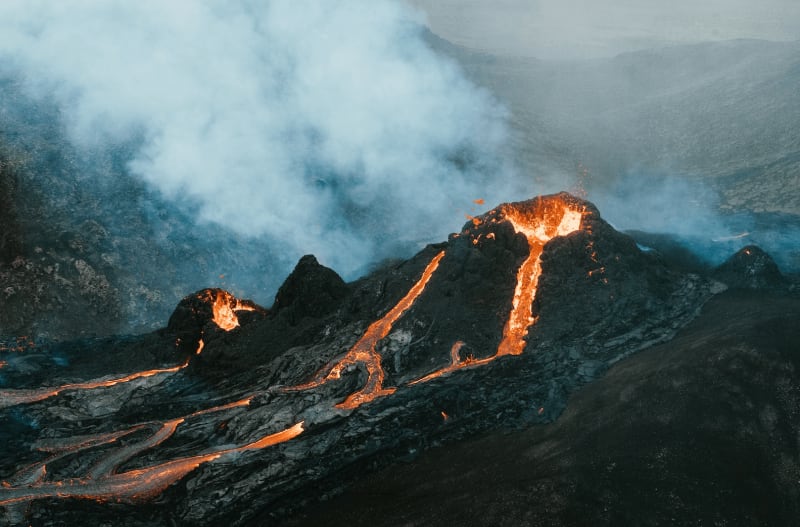
South Iceland, for example, has very few towns and villages mainly due to the fact that Katla and Eyjafjallajökull sit just north of the coast. An eruption of either volcano would not only produce a lot of lava and debris but because both are underneath glaciers, it would create a huge glacial flood and wipe out anything that stands in its way. This is why you can find barren black sand beaches in the south of Iceland because it's often been the site of great volcanic induced floods.
Luckily, Iceland's evacuation measures have only seldom been put into action in modern times. In 1973 the eruption of Heimaey on Westman Islands was one of those cases. At the time of the eruption, there were 5,200 living on Westman Island. However, in the early hours of the 22nd of January, a fissure opened in the ground and started tearing through the edge of town, splitting roads and buildings in half.
Evacuation measures were extremely fast and the population was safely brought to the mainland. They then started pumping cold seawater onto the lava to cool it down and to minimize the damage. Although 400 homes and much of the town's infrastructure were destroyed, only one person lost their life on that day. Today, Heimaey Island has been rebuilt and it's become a booming town where many whales and puffin watching tours operate from.
Despite the excellent prediction and evacuation response of Iceland, there are still certain dangers with eruptions that tourists traveling to Iceland should be aware of. An eruption can often emit large amounts of toxic gases. In the case of a volcanic eruption, remain indoors with the windows closed and check the local news and see what they suggest. An eruption in the Highlands can severely affect air quality in Reykjavik, depending on how the air is blowing. Warning about the air quality and eruptions can be found on the Icelandic weather website.
__________________ ## What Are Iceland's Most Historic Volcanic Eruptions?
Although volcanoes in Iceland are a relatively low threat to human life in Iceland, they can and have had serious wider implications to the world. In the last 1000 years, volcanoes from Iceland have indirectly made a huge impact in shaping the modern world. From the French revolution to widespread drought in Egypt, take a look at some of Iceland's most historic volcano eruptions below.
Bárðarbunga Eruption 2014 - 2015
Between August 2014 and February 2015 there were a series of eruptions in the Bárðarbunga volcanic system. Large volumes of sulphur dioxide were emitted, which impacted the air quality of Iceland. Although it was only toxic to humans if you were close to the eruption, it is thought that it caused the death of thousands of sheep around the country which severely impacted the livelihood of Icelandic farmers.
Eyjafjallajökull Eruption 2010
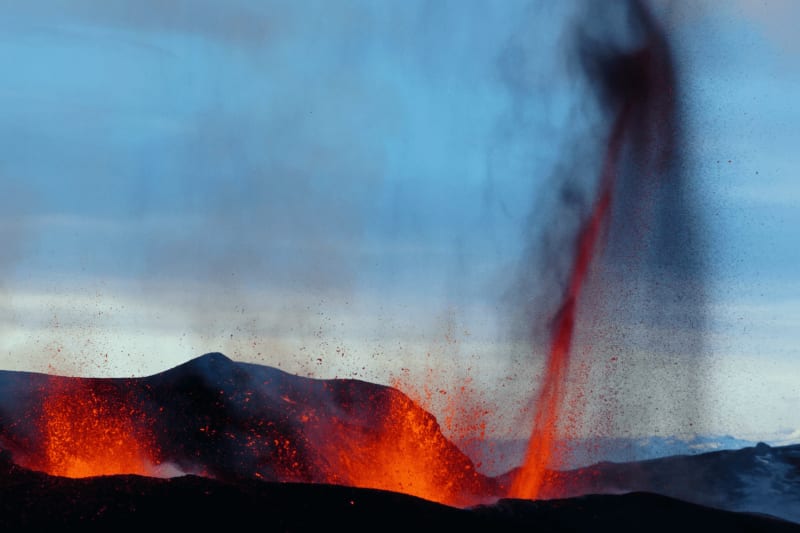
Vestmannaeyjar Eruption 1973
In the early hours of the 23rd January, a 300-meter fissure opened up nearby to the town of Heimaey island. The fissure rapidly grew from 300 meters to 2 kilometers and crossed the island from one shore to the other. An evacuation procedure almost immediately occurred and the 5,300 people of the island were safely brought to the mainland within a matter of a few hours via boats.
Surtsey Eruption 1963
Surtsey is a volcanic island that didn't exist prior to 1963. A series of eruptions that occurred 130 meters below sea level reached the surface within a few days. The island had an initial size of 2.7 km2 but due to sea erosion, it has been steadily declining in size and was measured to be 1.3 km2 in 2012. Only a select few scientists are allowed on the island as it's being used as a study ground to see how an island becomes inhabited by plants and animals.
Laki Eruption 1784
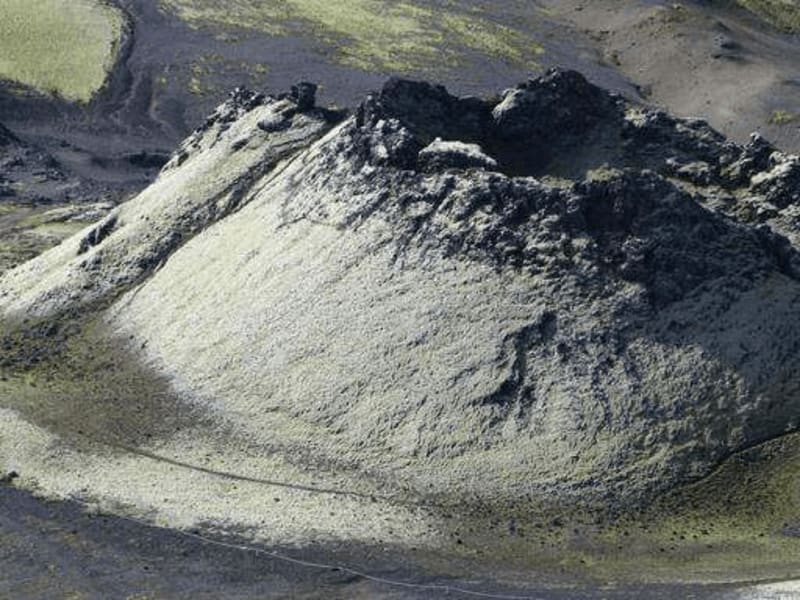
But Laki's impact also spread around the world, as it caused a dense fog across Europe. In the UK, an estimated 23,000 people lost their lives because of the toxic gases that were swept across the ocean. The fog also led to ports shutting down and crops failing, causing widespread famine. Historians consider Laki to be a driving catalyst for the French Revolution which occurred in 1789.
FYI: The consequences of the eruption even went as far as Egypt where the volcanic smog lowered temperatures, which reduced rainfall and dried up the Nile. A sixth of the country was killed as a result of the drought. In total, nearly six million people were killed as a result of the Laki eruption in 1784.
___________________________
Öræfajökull (pronounced: "Err iver yerkotl") Eruption 1362
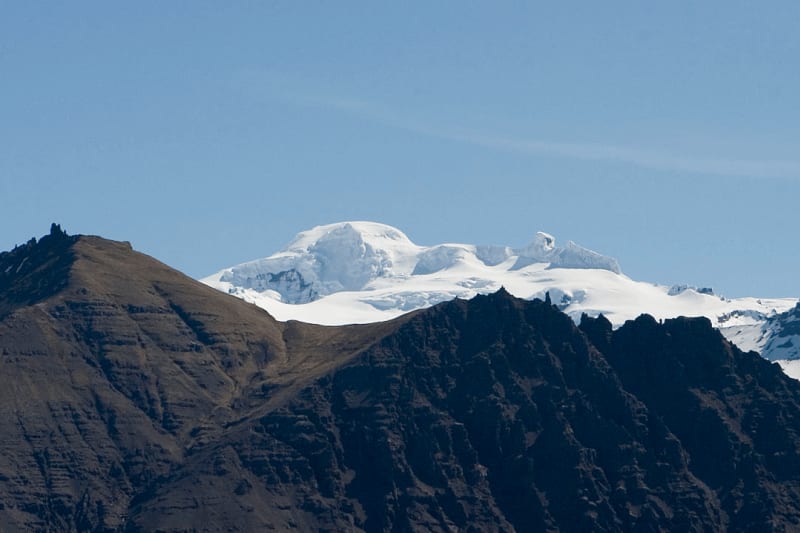
Volcanoes in Icelandic folklore: legends and stories
The first settlers from Norway and abroad didn't have the scientific knowledge of today. Therefore, it's not surprising that folklore and legends were created in an attempt to try and explain their existence.
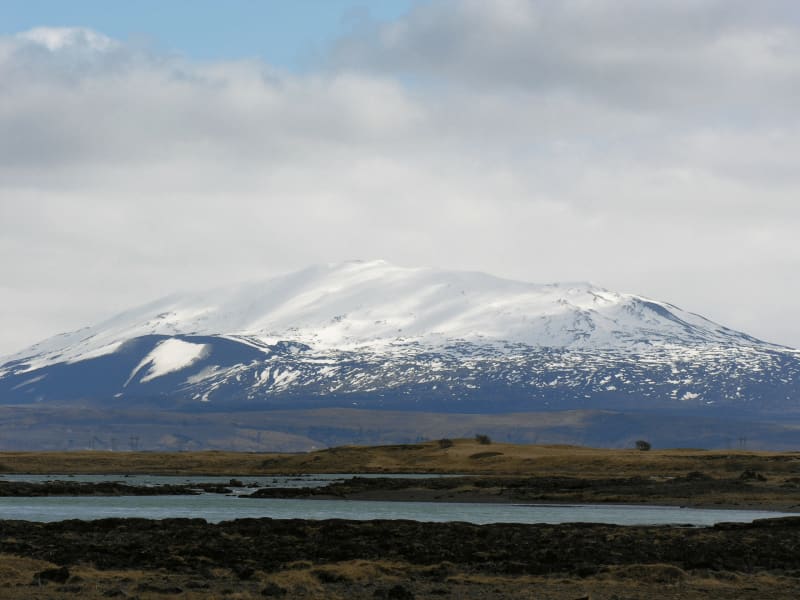
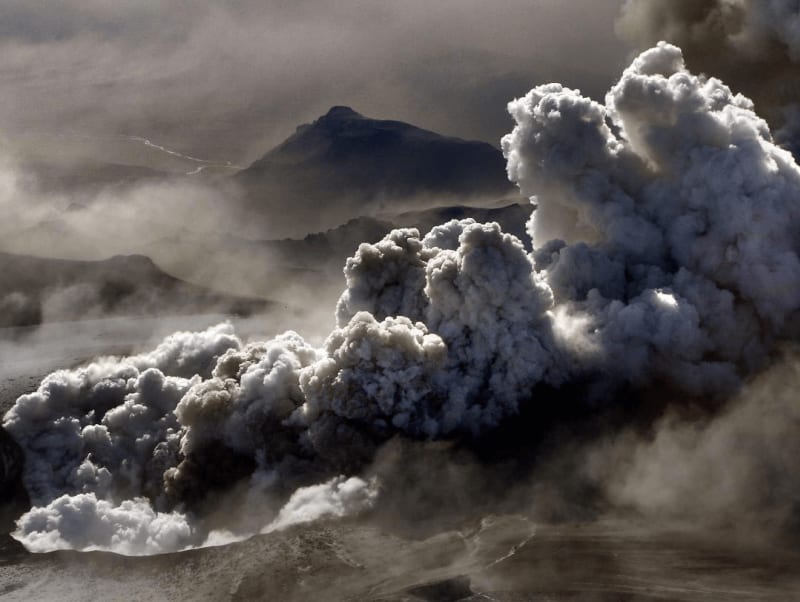
One day Barði couldn't find the sheep, and knowing that he would be in great trouble if the sheep went missing he stole Katla's trousers. Katla discovered her trousers had been stolen by the shepherd boy and in rage murdered him and placed him in a large vat of whey. As the summer went on the whey was slowly used up and the villagers kept hearing her mutter. Soon Barði will appear. When Katla couldn't bear the suspense of the shepherd boy being found soon she put on her trousers and raced towards Mýrdal glacier and threw herself into the canyon, which is now called Katla's Canyon.
Shortly after she disappeared Katla volcano erupted, melting part of the glacier and causing a great flood to wash over the entire south coast of Iceland. Ever since, when a volcanic flood occurred, it was believed it was the works of Katla the bewitched housekeeper.
How Does Iceland Take Advantage of its Many Volcanoes Today?
Although volcanoes have often caused widespread destruction in Iceland, they have also provided the country with a unique resource: geothermal energy. Today, over 30% of the country's electricity is generated by geothermal power stations, the remaining 70% is produced by hydro-electric sources. As well as electricity, geothermal energy is used to heat water for homes. The benefit of geothermal energy is that it is cheap and perhaps the most environmentally friendly source of energy as it is generated directly from the earth.
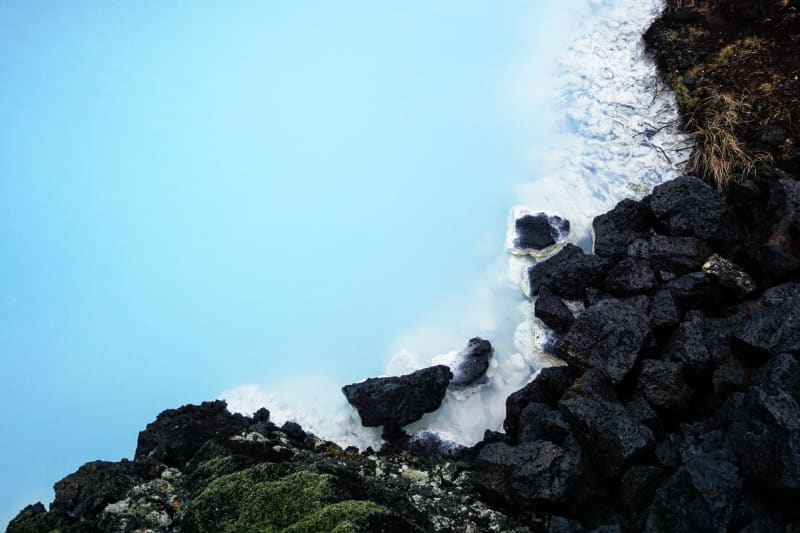
Blue Lagoon is an Icelandic Geothermal Spa and uses the heat from the earth to warm up it's grand blue lagoon. When the Svartsengi Resource Park came to life in the late 1970s, one of the unintended benefits of the plant's geothermal energy production was an enchanting reservoir that formed in the lava field beside the facility. No one knew it at the time, but this humble expanse signalled the dawn of the Blue Lagoon and the birth of a wonder of the world.
How to Best Experience Volcanoes in Iceland?
Over the last few years, there has been a boom in the number of tours available in Iceland to go and experience Volcanoes. Some people actually credit Eyjafjallajökull's 2010 eruption for Iceland's surge in tourism, as millions around the world, saw the magnificent landscapes in the news. How to best experience volcanoes in Iceland largely depends on what you are interested in.
While there are no eruptions at the time of writing this guide, many tours will adapt their program depending on the volcanic activity. Keep an eye out for special helicopter tours when a volcano goes off if you're interested to see the flowing lava up close.
It's important to note, however, that whatever tour you join in Iceland, you will see a volcano one way or another. As we mentioned earlier, there are 130 volcanoes in Iceland so it's near impossible to not see one. Any trip to the Snæfellsnes peninsula, for example, you'll be in the shadows of the huge Snæfellsjökull volcano. Drive along the famous ring road and you'll be passing volcanoes in all shapes and sizes along the way.
Take a look at our list below to get some ideas on how to make your experience with Iceland's volcanoes a once in a lifetime event.
Helicopter
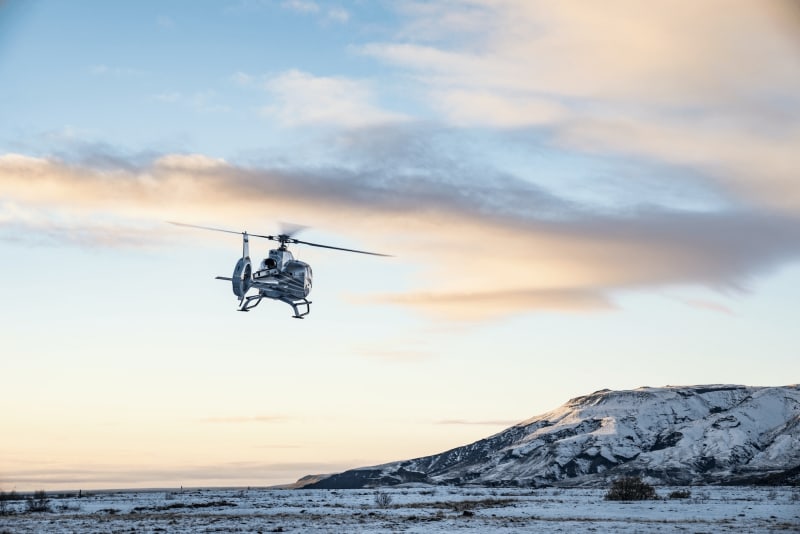
Hiking Tour
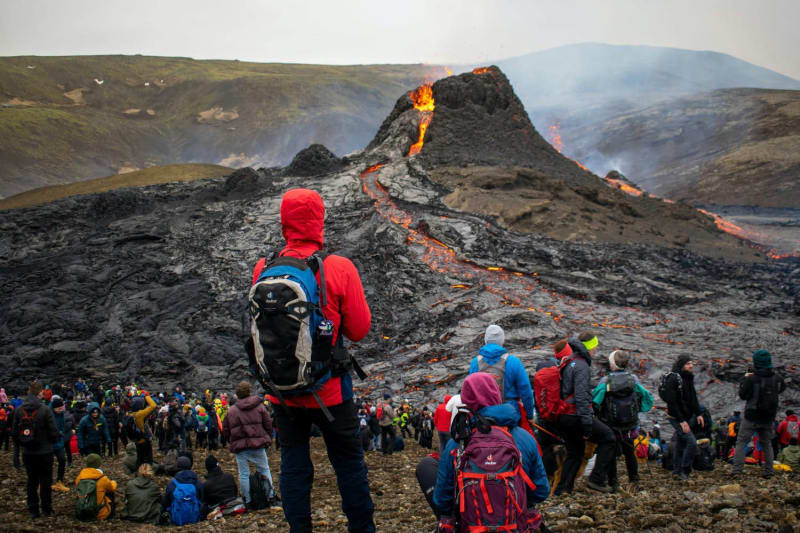
How about hiking up Vatnajökull, where several volcanoes hide beneath the layers of ice, such as Grímsvötn and Bárðarbunga. After hiking up Vatnajökull, you'll have a once in a lifetime opportunity to enter the blue ice cave. Chances are that if you join any hiking in Iceland, that you will see a Volcano in one form or another - take a look at all the tours here!
Rent Your Own Car
If you're up for the challenge then why not rent your own car and explore Iceland's volcanoes and landscapes at your own pace? Having your own car gives you the freedom to spend as long as you wish at any of the countless sites.
To answer that question, we recommend you take a look at this article below:
__________________________
Inside the Volcano Tour
So you've seen a volcano from the outside, but have you ever experienced one from the inside? If not, then this is your chance for perhaps the most unique tours of all. The Inside the Volcano tour allows you to plunge into the inside the magma chamber of a dormant volcano by use of a lift.
Top Ten Most Famous Volcanoes in Iceland
As we previously mentioned there are 130 known volcanoes to be found in Iceland. Whilst each one is beautiful in its own way, we have made a list of the top ten most notable volcanoes in Iceland that we recommend you check out. Take a look below!
Eyjafjallajokull: Iceland's Most Notorious Volcano
Last eruption: 2010
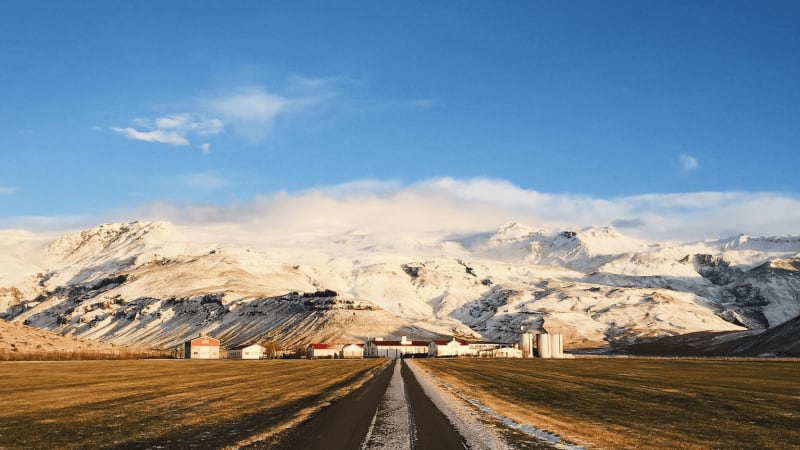
Fagradalur: Icelands Most Tourist Friendly Volcanic Eruption
Last eruption: 2021
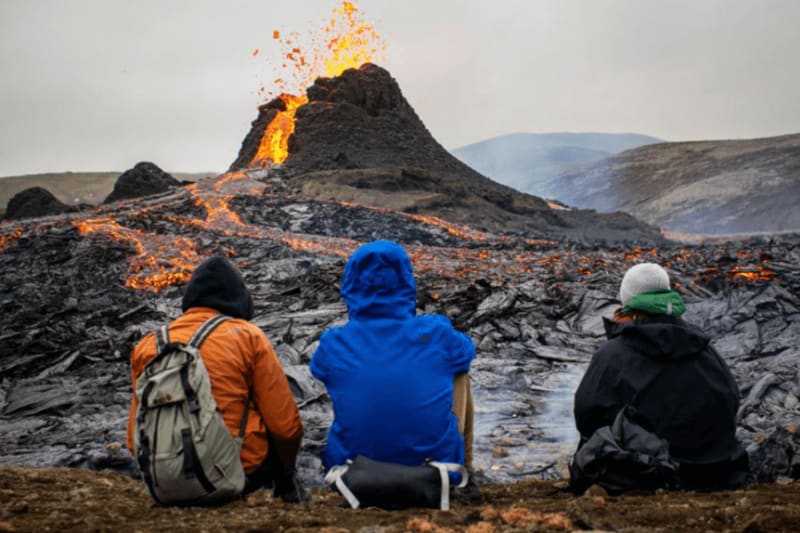
After weeks of speculation and shaking the earthquakes stopped and everything went quiet for about three days. On Friday evening, at 20:45 on March 19th, 2021, people in Grindavik started to report a glowing light in sky. There was no eruption tremor reported, so scientist and the Coast Guard flew over on a helicopter and confirmed that an eruptive fissure had opened in Geldingadalir. The eruption was small, far from populated areas and not expected to threaten the people or properties close by.
The volcano could be easily accessed. Usually when a volcanic eruption occurs people are supposed to stay away but I guess we do things differently in Iceland, so hundreds of Icelanders flocked to the eruption to witness the volcanic wonder. It turned out to be pretty safe after precautions were taken with Icelandic voluntary search and rescue teams ensuring safety at the site. For that reason, it is known as a very tourist friendly volcano.
The eruption has paused as of now (written on June 7th, 2022) but there are still earthquakes daily.
Even though the crater is quiet at the moment, we recommend visiting and witnessing that powerful scenery that was left behind.
Thrihnukagigur: Iceland's Only Volcano You Can Enter
Last eruption: ±2000 BCE
Also famous for the music video for "Way Down We Go" by Kaleo which was recorded below the surface of Thrihnukagigur.
Thrihnukagigur is a volcano near Reykjavík, Iceland, and as mentioned earlier, it's the only volcano that you can enter. The volcano covers an area of approximately 3,270 square meters and it's got a depth of 213 meters. Thrihnukagigur is a dormant volcano that hasn't erupted in the last 4,000 years.
Although it was originally discovered by the cave explorer Árni B Stefánsson in 1974, it wasn't opened to the public until 2012.Today you can descend into the depths of Thrihnukagigur with an open-air lift and experience the magma chamber from within. The lift is around 120 meters long and once you reach the bottom, the space is the same size as a football field. To put these sizes into perspective, one could easily fit the Statue of Liberty in New York inside the Thrihnukagigur volcano.
Apart from the experience of descending into a volcano, what makes this magma chamber beautiful to see are the amazing colors left behind from the elements that were brought up from inside the Earth. The walls have shades of yellow, green, red all from the iron, copper, and sulphur brought up from the earth's mantle.
Grimsvotn: Iceland's Most Active Volcano
Last eruption: 2011
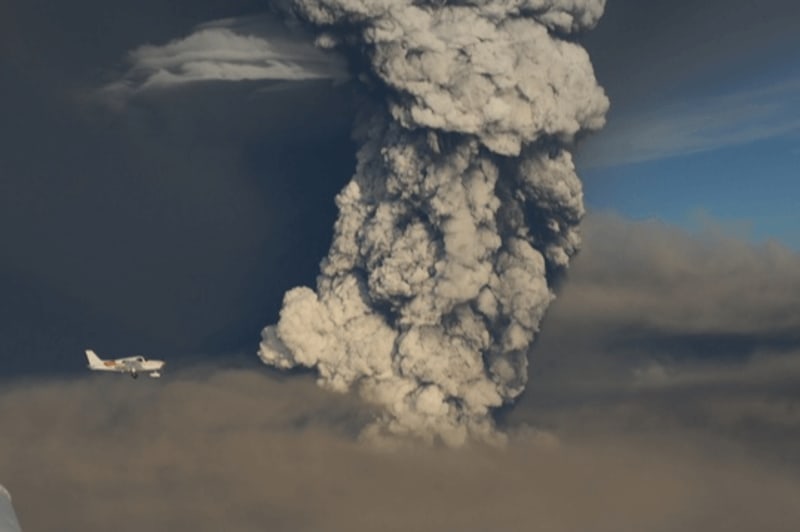
Because there is such a large ice cap above the volcano, every time it erupts it causes this ice to melt and results in huge floods to occur in southern Iceland. Grimsvotn last erupted in May 2011 causing a plume of ash to shoot out 12km high. The eruption caused the cancellation of over 900 flights in Iceland, Greenland, the UK, Norway, Ireland, and Germany.
Hekla Volcano: Hells' Entrance
Last eruption: 2000
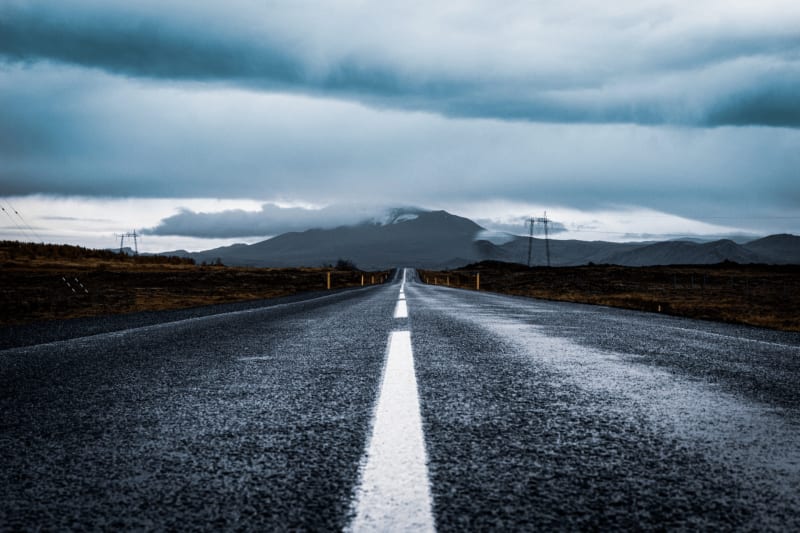
It reaches a height of 1,491 m (4,892 ft) and has become a popular place for hikers. If you're interested in climbing Hekla then be sure to visit the Hekla center where you can learn all about this impressive volcano.
Katla: Eyjafjallajokull's Explosive Neighbour
Last eruption: 1918
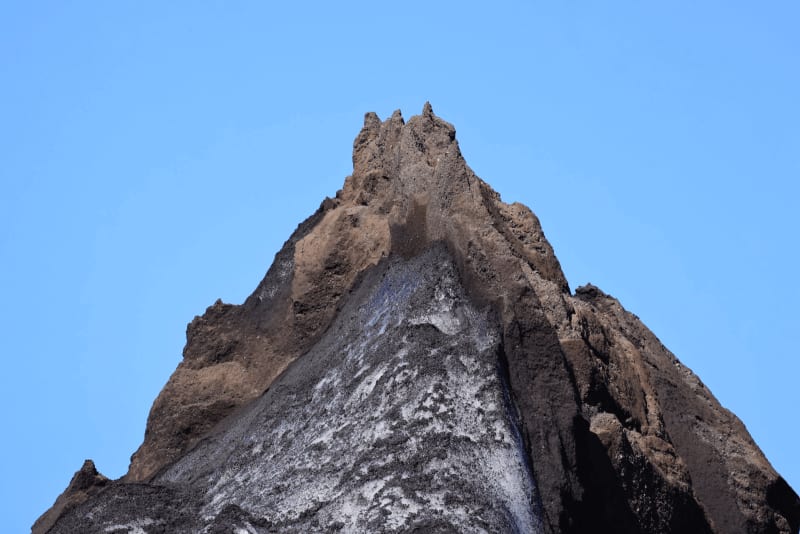
Snæfellsjökull: The Journey to the Center of the Earth
Last eruption: ±200 AD

Today Snæfellsjökull is one of Iceland's most popular volcanoes to visit, as it's located in the beautiful Snæfellsjökull National Park, north of Reykjavik. In the summer months, one can hike easily up to the summit, there are several hiking tours that can take you as well. In 2012 the summit of the volcano was ice-free for the first time ever in recorded history, clear evidence of the impact of a warming climate in Iceland.
Askja: Iceland's Geothermal Pool Volcano
Last eruption: 1961
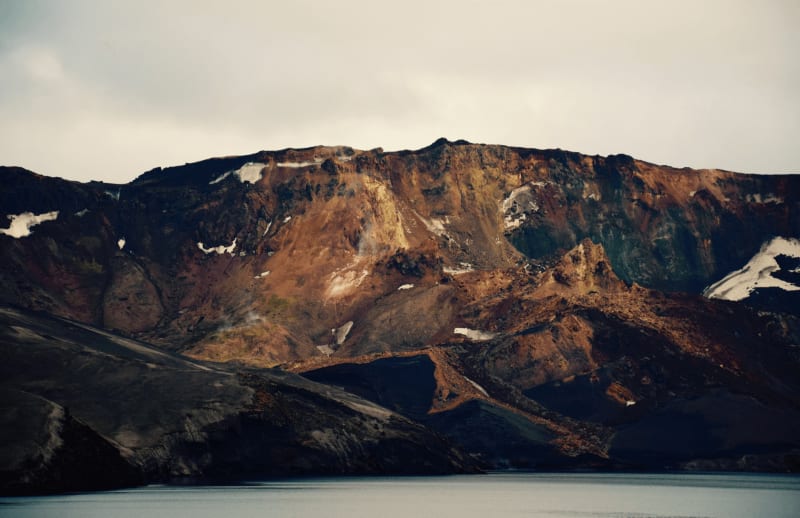
Since then the volcano has remained dormant and as a result of the eruption, you can now find a small geothermal lake called Víti that's warm enough to bathe in. It's located in a very remote part of the central highlands in Iceland, and is only reachable with an SUV, as there are only F-roads to get there. It's also only really accessible during the peak of the summer months in high summer months.
Krafla: The Geothermal Power Station Volcano
Last eruption: 1984
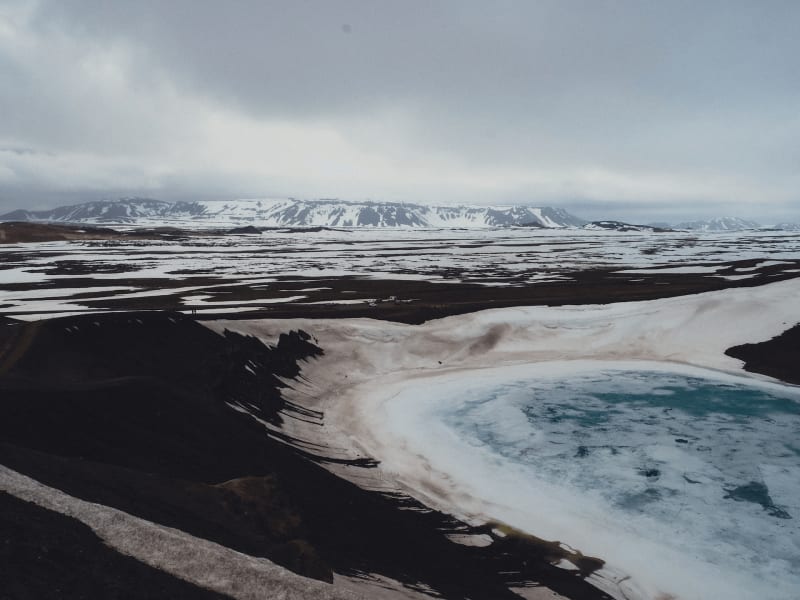
Krafla and the surrounding area have become a popular tourist destination because of the proximity to the Námafjall geothermal area. Here you can find many smoking fumaroles and boiling mud pot. Especially noteworthy are the multicolored sulphur crystals that have formed here. Be aware, however, the egg smell here can be quite pungent!
Hverfjall or Hverfell: Easy Hike-Around Volcano
Last eruption: 500BC
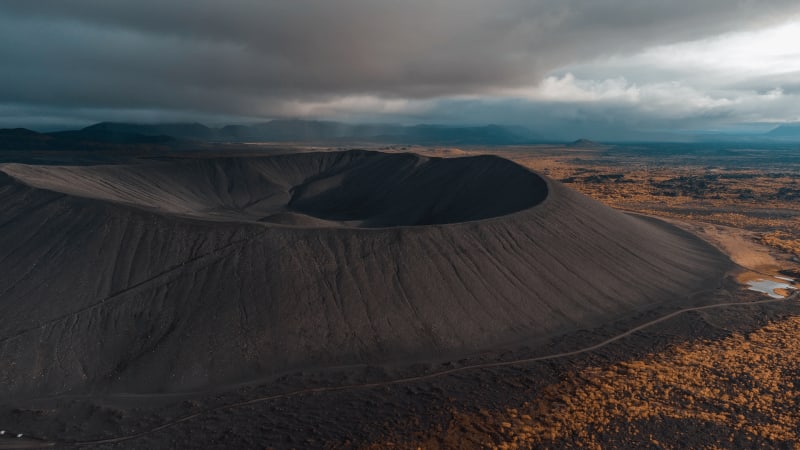
Eldfell
Last eruption: 1973
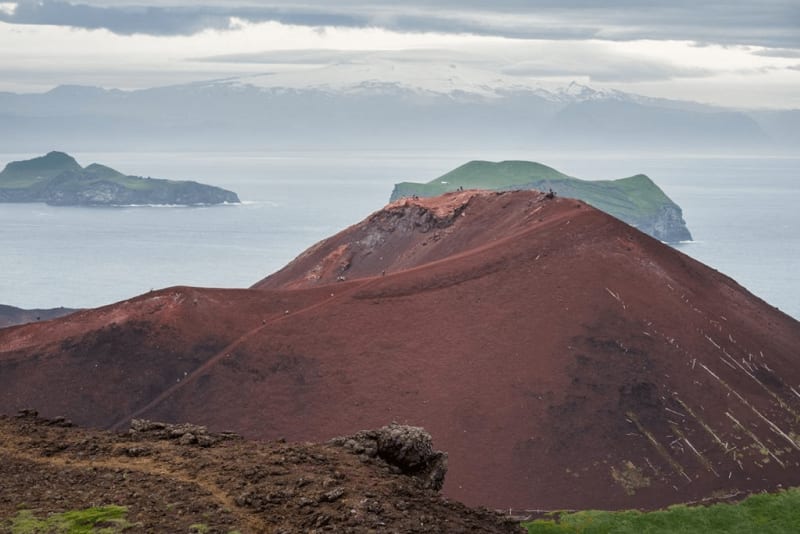
- Weather in Iceland
- The Complete Guide to Campervan Travel in Iceland
- Guide to Seeing the Northern Lights in Iceland
FAQ:
What volcano is erupting in Iceland right now?
At the moment, there is not an active volcano in Iceland. There have been many earthquakes recently (as of July 7th, 2022) and towns in Reykjanes are on high alert and with evacuation plans if needed to evacuate in a hurry.
SafeTravel is a great site to look at for real-time updates.
Was Iceland formed by a volcano?
Iceland is about 18 ? 25 million years old and is thus one of the youngest countries in the world. The formation of Iceland started about 60 million years ago when the mid-Atlantic ridge (the boundary between the North American tectonic plate and the Eurasian tectonic plate) started to give way and when mantle plumes appeared. Initially, Greenland was above the mantle plumes in Iceland and its thickness prevented volcanic activity but as Greenland drifted towards the southeast from where Iceland is currently, the mantle plumes became highly active.
When Greenland finally drifted off the mantle plumes, massive volcanic activity started generating basalt lava over the ocean. The hot lava rose from the ocean floor to the surface and cooled off to become a new crust and fill the rift valleys. New crust was created through a constant activity of these volcanoes. Some of these drifted with Greenland and can be found in eastern Greenland as well as western Scotland and in parts of Faroe Islands.

